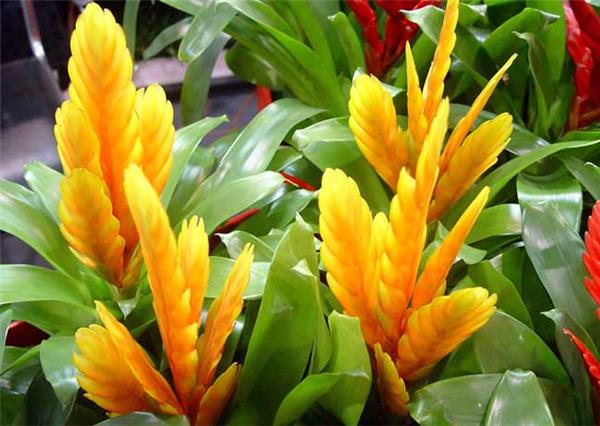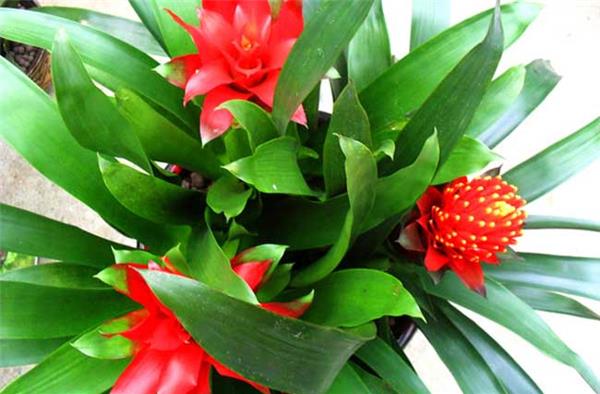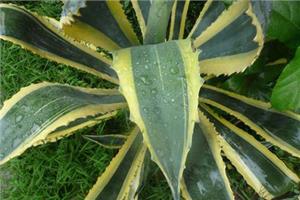The culture method of pineapple how to raise pineapple
Pineapple is native to the jungles from Mexico to southern Brazil and northern Argentina. Pineapple is a kind of ornamental plant with strong ornamental flowers and leaves, especially can be cultivated indoors. As a family horticulture, it is of high taste, and many people do not know how to raise pineapple. This paper introduces the breeding methods and matters needing attention of pineapple.

Propagation methods of pineapple flower
Pineapple has become the most important ornamental flower in the room, and there are many flower friends who like to preserve pineapple, and the breeding methods of pineapple can be divided into three kinds: cuttage propagation, ramet propagation, sowing propagation and so on.
1. Ramet propagation: small buds will grow in the axils of the leaves at the base of the ornamental pineapple flowers. When they grow 5-6 leaves, they can be cut off and propagated, and roots can be produced in about 1 month.
2. Cuttage propagation: it can be combined with changing pots in spring, cutting the small tubers from the tubers of the mother plant, or using the roots of the old pineapple to avoid shade, moisturize and keep warm. The soil uses rotten leaf soil and plain sandy soil in half, and when the root system grows to 2-3 cm, it can be planted.
3. Sowing and propagation: under the condition of 25 ℃ to 30 ℃, the seeds obtained by artificial pollination after flowering can emerge in about 4 weeks and grow into flowering pineapple plants in 3 to 4 years.
Culture methods of pineapple
1, lighting: pineapple habits like semi-overcast, should prevent the hot sun exposure, put half-shaded place or bright window, indoor. The original state of the pineapple is parasitic under a tree in the tropical rain forest, so it does not have a great demand for sunlight. When the sun is exposed to too much time, it will produce some leaves yellowing, and then, the flower tip is a little dry, and so on. If cultivated outdoors in spring, summer and autumn, it should be properly shaded, especially 70% shading in summer. Direct sunlight will make the leaf temperature higher than the air temperature. If the leaf temperature is too high, there will be burns and scorched leaves, which will fade the bud and slow the leaf growth.
2. Temperature: the optimum growth temperature of cultivated pineapple is 20 ℃ to 30 ℃, the highest temperature should not exceed 35 ℃, and the lowest temperature is 14 ℃. Freezing injury may occur at any time when it is lower than 10 ℃. It is best not to put it under the heater in winter, because in that case, it will be particularly dry and will be roasted, just like a person cannot always stand next to the heater and get hot easily.

3. Moisture: the surface of the basin soil of the pineapple family should be slightly dry, that is, the surface of the soil should be slightly dry, and the soil surface should be watered for a second time. It should not be too wet, and it is easy to soak the roots if too wet. All plants of the pineapple family have a leaf tube at the root of the leaf, and the leaf tube has a sink. It is necessary to ensure that there is often water in the tank, which cannot be cut off. After a period of time, for example, about ten days, the water in the leaf tube should be replaced to avoid smelly water. Usually, you can also spray some foggy water on the surface, leaves, and flowers. The optimum air relative humidity is 70% to 80%, and should not be less than 50%, because keeping the high air humidity in the cultivation environment is the key to the successful cultivation of Anthurium andraeanum. Therefore, foliar spraying should be carried out all the year round.
4. Use soil: potted red palm should choose the matrix with good drainage, and the mixed substrate of peat, perlite and sand for large-scale production, the ratio is: 1 cubic meter of peat: 4 to 5 kilograms of perlite: 0.15 cubic meter of sand. Its PH value remains between 5.5 and 6.5. If you can put a small amount of rotten chicken manure, cake powder or bone meal and other base fertilizer in the bottom of the basin, it will grow better.
5. Fertilization: during the growing season from April to September every year, liquid fertilizer should be applied every two weeks, fermented organic fertilizer can be applied, 0.1% urea and 0.2% potassium dihydrogen phosphate solution can be sprayed on the front and back of the leaves, and some extremely thin liquid fertilizer can be injected into the leaf tube, which is absorbed by the scales at the base, and the ratio of nitrogen, phosphorus and potassium is 10: 15: 20.
Matters needing attention in culture
1. Late spring to autumn is the growing period of pineapple flowers, which can appropriately increase the amount of water, and some clear water can also be irrigated in the leaf tube. You should change the water once a month to prevent the water from deteriorating and smelly.
2, often spray foliar water, dry some on the basin in winter, but not too much.
3. From May to September, nitrogen fertilizer should be applied once a week, and phosphorus and potassium fertilizer should be applied appropriately before flowering to promote the flower to be colorful.
4. when flowering, do not irrigate in the tube, store it in a place away from the sun, which can prolong the flowering period.
5. When entering the dormant period after anthesis, the pedicel must be cut off to reduce the consumption of nutrients.
6. Don't fill the tube with water in winter.
The above is the introduction of pineapple culture methods and matters needing attention. Pineapple is very suitable for interior decoration. It likes adequate sunlight for at least 3 hours a day, but it is also resistant to semi-shade, cool and ventilated in summer, and can also bear dry climate slightly.
- Prev

Not only to appreciate the efficacy and function of carnations Introduction
Not only to appreciate the efficacy and function of carnations Introduction
- Next

Culture conditions of Phnom Penh tequila hydroponics of Phnom Penh tequila
Culture conditions of Phnom Penh tequila hydroponics of Phnom Penh tequila
Related
- Wuhan Hospital Iron Tree Blooming Result Was Instantly Frightened by the Gardener Master
- Which variety of camellia is the most fragrant and best? Which one do you like best?
- What is the small blue coat, the breeding methods and matters needing attention of the succulent plant
- Dormancy time and maintenance management of succulent plants during dormancy
- Minas succulent how to raise, Minas succulent plant pictures
- What are the varieties of winter succulent plants
- How to raise succulent plants in twelve rolls? let's take a look at some experience of breeding twelve rolls.
- Attention should be paid to water control for succulent plants during dormant period (winter and summer)
- Watering experience of twelve rolls of succulent plants
- Techniques for fertilizing succulent plants. An article will let you know how to fertilize succulent plants.

